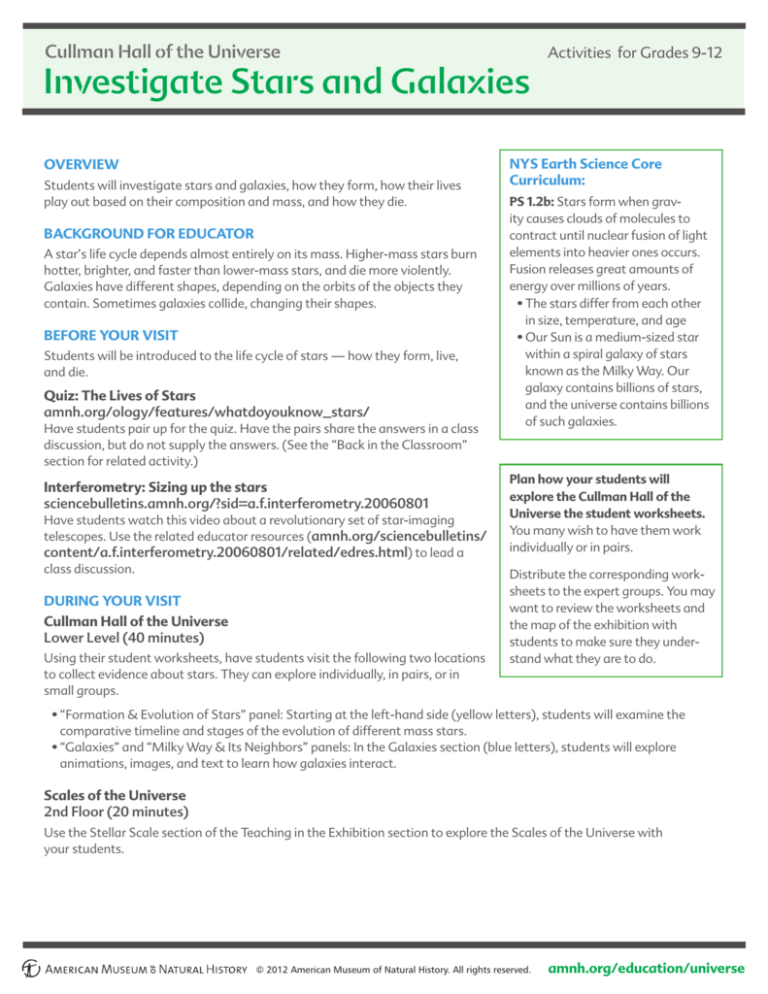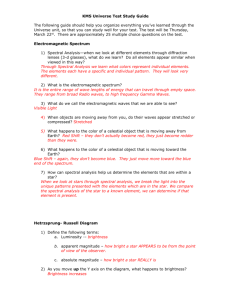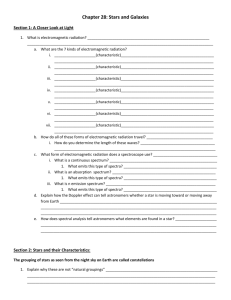
Cullman Hall of the Universe
Investigate Stars and Galaxies
OVERVIEW
Students will investigate stars and galaxies, how they form, how their lives
play out based on their composition and mass, and how they die.
BACKGROUND FOR EDUCATOR
A star’s life cycle depends almost entirely on its mass. Higher-mass stars burn
hotter, brighter, and faster than lower-mass stars, and die more violently.
Galaxies have different shapes, depending on the orbits of the objects they
contain. Sometimes galaxies collide, changing their shapes.
BEFORE YOUR VISIT
Students will be introduced to the life cycle of stars — how they form, live,
and die.
Quiz: The Lives of Stars
amnh.org/ology/features/whatdoyouknow_stars/
Have students pair up for the quiz. Have the pairs share the answers in a class
discussion, but do not supply the answers. (See the “Back in the Classroom”
section for related activity.)
Interferometry: Sizing up the stars
sciencebulletins.amnh.org/?sid=a.f.interferometry.20060801
Have students watch this video about a revolutionary set of star-imaging
telescopes. Use the related educator resources (amnh.org/sciencebulletins/
content/a.f.interferometry.20060801/related/edres.html) to lead a
class discussion.
DURING YOUR VISIT
Cullman Hall of the Universe
Lower Level (40 minutes)
Using their student worksheets, have students visit the following two locations
to collect evidence about stars. They can explore individually, in pairs, or in
small groups.
Activities for Grades 9-12
NYS Earth Science Core
Curriculum:
PS 1.2b: Stars form when gravity causes clouds of molecules to
contract until nuclear fusion of light
elements into heavier ones occurs.
Fusion releases great amounts of
energy over millions of years.
•T
he stars differ from each other
in size, temperature, and age
•O
ur Sun is a medium-sized star
within a spiral galaxy of stars
known as the Milky Way. Our
galaxy contains billions of stars,
and the universe contains billions
of such galaxies.
Plan how your students will
explore the Cullman Hall of the
Universe the student worksheets.
You many wish to have them work
individually or in pairs.
Distribute the corresponding worksheets to the expert groups. You may
want to review the worksheets and
the map of the exhibition with
students to make sure they understand what they are to do.
• “ Formation & Evolution of Stars” panel: Starting at the left-hand side (yellow letters), students will examine the
comparative timeline and stages of the evolution of different mass stars.
• “ Galaxies” and “Milky Way & Its Neighbors” panels: In the Galaxies section (blue letters), students will explore
animations, images, and text to learn how galaxies interact.
Scales of the Universe
2nd Floor (20 minutes)
Use the Stellar Scale section of the Teaching in the Exhibition section to explore the Scales of the Universe with
your students.
© 2012 American Museum of Natural History. All rights reserved.
amnh.org/education/universe
Cullman Hall of the Universe
Activities for Grades 9-12
BACK IN THE CLASSROOM
Discussion: Stars
As a group, compare the worksheets and discuss the way students interpreted the data they recorded in the two charts.
Ask: What patterns did they notice? (Answers will vary but may include: The temperature of a star determines its color;
in the Main Sequence stars, hotter stars are brighter; the larger a star’s mass to begin with, the shorter its life.)
Activity: Exploring Brown Dwarfs
Have students watch the Science Bulletins video “Brown Dwarfs: Tail End of the Stars” (sciencebulletins.amnh.org/
?sid=a.f.brown_dwarfs.20110606) to learn what happens when there isn’t quite enough mass to make a low-mass star.
Allow students to take notes during the video. Then ask the following questions. (You may want them to watch the video
a second time.)
•W
hy don’t brown dwarfs shine?
(Answer: They don’t have enough mass to produce the temperatures and densities in their core that lead to nuclear
fusion. Nuclear fusion causes stars to shine.)
•H
ow does astronomer Quinn Konopacky study brown dwarfs?
(Answer: Earth’s atmosphere is turbulent and distorts light coming from space. The Adaptive Optics System measures
that turbulence and sends that information to a deformable mirror, which compensates for the distortion and obtains
a sharp image.)
•H
ow can Quinn determine the mass of a brown dwarf?
(Answer: How quickly or how slowly an object orbits another object depends on how massive it is. Quinn determines a
brown dwarf’s mass by measuring the speed of its orbit.)
•T
heorists measure an object’s heat, brightness, and age and enter this data into computer models in order to predict
its mass. Often the data Quinn collects does not match up with their predictions. How does this help theorists?
(Answer: Theorists enter the new data to make their models more accurate.)
Actvity/Discussion: The Lives of Stars
Have students retake the Ology quiz that they took before their Museum visit. Give out the answers and have them
compare their pre- and post-visit scores. Ask: Did their scores improve? Are there questions they could research further?
(Answers will vary.)
© 2012 American Museum of Natural History. All rights reserved.
amnh.org/education/universe
Cullman Hall of the Universe
Grades 9-12
Student Worksheet: Investigate Stars
Go to the “STARS” wall (in yellow letters).
1. Read the panel: “Formation and Evolution of Stars”. What universal force causes star formation?
2. Look at the wall panels illustrating the “Lives of Stars” and describe different-mass stars at the different stages of their
development in the appropriate box:
STAR TYPE
BIRTH
LIFE
OLD AGE
DEATH
REMNANT
Low-mass star
x Sun’s mass:
Age at death:
IntermediateMass Star
x Sun’s mass:
Age at death:
High-mass star
x Sun’s mass:
Age at death:
Very High-mass
star
Age at death:
Comparing the information in the “Star Type” column, what can you say about the relationship between a star’s mass
and its lifespan?
© 2012 American Museum of Natural History. All rights reserved.
amnh.org/education/universe
Cullman Hall of the Universe
Grades 9-12
3. Look at the “Organizing the Stars” panel. The HR diagram shows stars organized according to their luminosity
(brightness) and temperature.
Using the information in the diagram and also in the sections on star type you used in the chart above, record the
following information about each star:
STAR NAME
LUMINOSITY
(relative to the sun)
TEMPERATURE
STAR TYPE/COLOR
Spica
Sirius
Polaris
The Sun
Sirius B
Barnard’s star
How do star temperature and luminosity relate to the star type and color?
Go to the “GALAXY” wall (in blue letters).
4. Look at the “Formation of a Galaxy” panel and Galaxy wall. Read about what a galaxy is and the different types that
have been observed.
What holds stars in galaxies?
Why are galaxies different shapes?
5. Read the panel on the Milky Way and its neighbors, and look at the animation on the floor of the colliding galaxies.
Describe how galaxies interact and why:
© 2012 American Museum of Natural History. All rights reserved.
amnh.org/education/universe
Cullman Hall of the Universe
Grades 9-12
Student Worksheet: Investigate Stars
ANSWER KEY
Go to the “STARS” wall (in yellow letters).
1. Read the panel: “Formation and Evolution of Stars”. What universal force causes star formation?
(Answer: gravity)
2. Look at the wall panels illustrating the “Lives of Stars” and describe different-mass stars at the different stages of their
development in the appropriate box:
STAR TYPE
BIRTH
LIFE
Low-mass star
x Sun’s mass:
(8-80%)
(Born in a cluster
with other stars,
a gravitational
collapse of material initiates a
nuclear fusion
reaction.)
(The low rate of
nuclear fusion
could last for trillions of years —
longer than the
current age of the
universe!)
(Born in a cluster
with other stars,
a gravitational
collapse of material initiates a
nuclear fusion
reaction.)
Age at death:
(1 trillion years)
IntermediateMass Star
x Sun’s mass:
(.8-8)
Age at death:
(10 billion years)
High-mass star
x Sun’s mass:
(8-20)
Age at death:
(10 million years)
Very High-mass
star
(20-100)
Age at death:
(1 million years)
DEATH
REMNANT
X
(At the end of its
life, a low-mass
star transitions
into a red giant.)
(After shedding
most of its mass
during the red
giant phase, a
white dwarf star
remains.)
(During most
of its life, a star
fuses hydrogen
and helium in its
core.)
(Towards the
end of its life,
an intermediatemass star
transitions into
a red giant.)
(After the star
exhausts its fuel,
its atmosphere is
blown off, creating a planetary
nebula.)
(The hot core of
the star is left
behind as a white
dwarf.)
(Born in a cluster
with other stars,
a gravitational
collapse of material initiates a
nuclear fusion
reaction.)
(Because of the
(When the nuclear fusion in the
core progresses
through heavier
elements, the star
expands into a
supergiant.)
(A high mass star
dies in a supernova explosion,
expelling about
90% of its mass.)
(The collapsed
material remaining after the supernova forms an
extremely dense
object called a
neutron star.)
(Born in a cluster
with other stars,
a gravitational collapse of material
initiates a nuclear fusion reaction. A star
cannot form at more
than 100x the mass
of the Sun.)
(The fuel in a
very high-mass
star is exhausted
quickly.)
(A very high mass
star becomes a
very large and
luminous
supergiant at the
end of its life.)
(Death usually
comes in the form
of a supernova
explosion, as in
the case of the
high-mass star.)
(The collapse of a
very high-mass star
results in a black
hole, which warps
the fabric of space
so much that light
cannot escape, and
therefore it cannot
be seen directly.)
high rate of energy
that is produced by
nuclear fusion in a
high-mass star, its
fuel burns quickly.)
OLD AGE
Comparing the information in the “Star Type” column, what can you say about the relationship between a star’s mass
and its lifespan?
(Answer: The larger mass a star begins with, the shorter its lifespan will be.)
© 2012 American Museum of Natural History. All rights reserved.
amnh.org/education/universe
Cullman Hall of the Universe
Grades 9-12
ANSWER KEY
3. Look at the “Organizing the Stars” panel. The HR diagram shows stars organized according to their luminosity
(brightness) and temperature.
Using the information in the diagram and also in the sections on star type you used in the chart in Step 2, record the
following
information about each star: (Teacher’s Note: Because the HR diagram only designates some temperatures
and luminosities on the axes, all student readings from the chart will be very approximate. You may supplement this
activity using the Earth Science Regents resource table called “Characteristics of Stars”.)
STAR NAME
LUMINOSITY
(relative to the sun)
TEMPERATURE
STAR TYPE/COLOR
Spica
~10 3
35,000°C
main sequence/blue
Sirius
~75
10,000°C
main sequence/blue
Polaris
~10 4
6,000°C
Giant star/yellow-white
The Sun
1
5,000°C
Main sequence/yellow
Sirius B
~.001
8,000°C
White dwarf
Barnard’s star
~10 -5
3,000°C
Main sequence /red
How do star temperature and luminosity relate to the star type and color?
(Answer: The temperature of a star determines its color; in the Main Sequence stars, higher temperature
correlates also correlates to higher luminosity.)
Go to the “GALAXY” wall (in blue letters).
4. Look at the “Formation of a Galaxy” panel and Galaxy wall. Read about what a galaxy is and the different types that
have been observed.
(Answer: gravity)
What holds stars in galaxies?
Why
are galaxies different shapes? (Answer: The initial orbits and collective rotation of stars and other material in a galaxy
determines its shape. These are determined by its formation, e.g. from a disk of gas, from a collision of two galaxies.)
5. Read the panel on the Milky Way and its neighbors, and look at the animation on the floor of the colliding galaxies.
Describe
how galaxies interact and why:
(Answer: The proximity of the two disk or spiral galaxies allows their
gravity to distort each other. If they become close enough they may even combine, creating a larger and
elliptically-shaped galaxy.)
© 2012 American Museum of Natural History. All rights reserved.
amnh.org/education/universe










